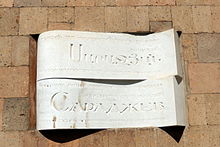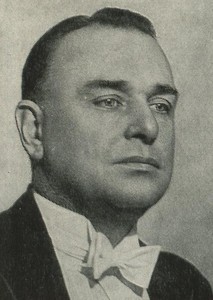
Konstantin Solomonovich Sarajev (Sarajjev, Konstantin) |
Sarajev, Konstantin
People’s Artist of the Armenian SSR (1945). Saradzhev’s activity embodies, as it were, the continuity of Soviet musical culture with Russian classics. The creative personality of the young musician developed at the Moscow Conservatory under the beneficial influence of his teachers – S. Taneyev, I. Grzhimali, V. Safonov, N. Kashkin, G. Konyus, M. Ippolitov-Ivanov. After graduating from the conservatory in 1898, Saradzhev began performing independent concerts as a violinist. He even traveled to Prague to improve with the famous violinist O. Shevchik. However, already in those years he dreamed of becoming a conductor. In 1904, Saradzhev went to Leipzig to study with A. Nikish. The outstanding conductor highly appreciated the abilities of his student, who came from Russia. Professor G. Tigranov writes: “Under the guidance of Nikish Saradzhev developed an excellent conducting technique – that expressive, clear and plastically clear gesture, that ability to subordinate the orchestra to his artistic goals, which, improving and enriching, subsequently formed the basis of his own performing style.”
Upon his return to Moscow, Saradzhev devoted himself with amazing energy to versatile musical activities, starting his conducting career in 1908 and mastering the most complex scores with unique speed. So, according to G. Konyus, in four months of 1910 Saradzhev conducted 31 concerts. The programs included about 50 major orchestral works and 75 smaller ones. At the same time, many of them sounded for the first time. Saradzhev presented new works by Debussy, Stravinsky, Prokofiev, Ravel, Myaskovsky and other authors to the judgment of Russian listeners. The “Evenings of Contemporary Music”, founded by him together with the music critic V. Derzhanovsky, played a huge role in the development of the cultural life of Moscow. At the same time, he conducted opera performances at the Sergiev-Alekseevsky People’s House, performing interesting productions of Tchaikovsky’s Cherevichek, Ippolitov-Ivanov’s Treason, Rachmaninoff’s Aleko, Mozart’s Marriage of Figaro, and Massenet’s Werther. Konyus wrote then that “in the person of Saradzhev, Moscow has a tireless, devoted interpreter and commentator on works of musical art. Giving his talent to learning not only recognized creations, but to the same extent also creations awaiting recognition, Saradzhev thereby renders an invaluable service to domestic creativity itself.
Welcoming the Great October Revolution, Saradzhev gladly gave his strength to the construction of a young Soviet culture. Continuing his activities as a conductor in various cities of the USSR (opera theaters in Saratov, Rostov-on-Don), he was also one of the first artists of our country who successfully performed abroad and promoted Soviet music there. Sarajev teaches at educational institutions, organizes musical ensembles and orchestras, both professional and amateur. All this work greatly fascinated Saradzhev, who, according to B. Khaikin, “was a musician of a democratic direction.” On his initiative, a conducting department was opened at the Moscow Conservatory. The creation of the Soviet conducting school is largely the merit of Saradzhev. He brought up a galaxy of young musicians, including B. Khaikin, M. Paverman, L. Ginzburg, S. Gorchakov, G. Budagyan and others.
Since 1935, Sarajev lived in Yerevan and made a significant contribution to the development of Armenian musical culture. Head and chief conductor of the Yerevan Opera and Ballet Theater (1935-1940), at the same time he was one of the organizers and then artistic director of the Armenian Philharmonic; since 1936, a venerable musician – director of the Yerevan Conservatory. And everywhere Saradzhev’s activity left an indelible and fruitful mark.
Lit .: K. S. Saradzhev. Articles, memories, M., 1962.
L. Grigoriev, J. Platek





